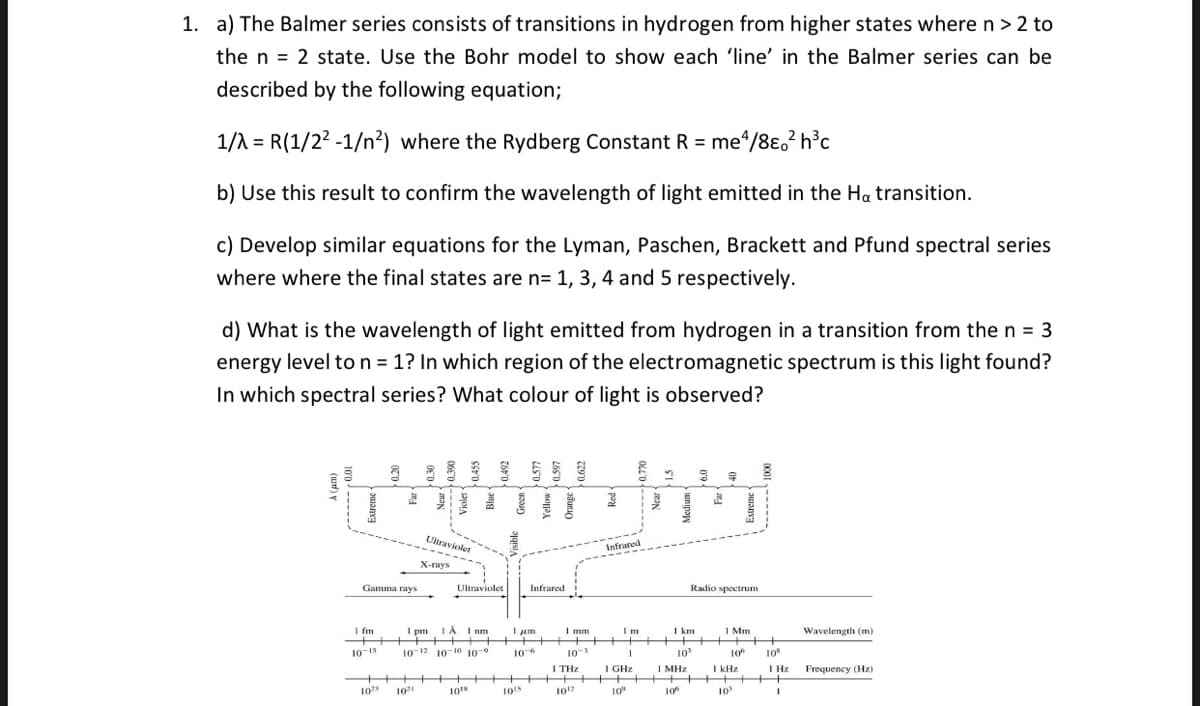1. a) The Balmer series consists of transitions in hydrogen from higher states where n > 2 to the n = 2 state. Use the Bohr model to show each 'line' in the Balmer series can be described by the following equation; 1/λ = R(1/2² -1/n²) where the Rydberg Constant R = me4/8ε ² h³c b) Use this result to confirm the wavelength of light emitted in the Ha transition. c) Develop similar equations for the Lyman, Paschen, Brackett and Pfund spectral series where where the final states are n= 1, 3, 4 and 5 respectively. d) What is the wavelength of light emitted from hydrogen in a transition from the n = 3 energy level to n = 1? In which region of the electromagnetic spectrum is this light found? In which spectral series? What colour of light is observed? 10-15 a Gamma rays 10 R Ultraviolet 1071 X-rays Ultraviolet 1 pm IA Inm 10-12 10 10 10 9 10¹ Infrared 1 μm 106 10¹5 10- 1 THz 10¹2 2 frared Im 1 I GHz 15 10" 1 km 1 MHz 3 10³ 10 2 Radio spectrum OPP 1 Mm HHHHH+ 10 1 kHz 8 ▬▬▬▬▬▬▬▬▬▬▬▬▬▬▬▬▬▬▬▬▬▬▬▬▬▬▬▬▬▬ 10² 10⁰ 1 Hz I Wavelength (m) Frequency (Hz)
1. a) The Balmer series consists of transitions in hydrogen from higher states where n > 2 to the n = 2 state. Use the Bohr model to show each 'line' in the Balmer series can be described by the following equation; 1/λ = R(1/2² -1/n²) where the Rydberg Constant R = me4/8ε ² h³c b) Use this result to confirm the wavelength of light emitted in the Ha transition. c) Develop similar equations for the Lyman, Paschen, Brackett and Pfund spectral series where where the final states are n= 1, 3, 4 and 5 respectively. d) What is the wavelength of light emitted from hydrogen in a transition from the n = 3 energy level to n = 1? In which region of the electromagnetic spectrum is this light found? In which spectral series? What colour of light is observed? 10-15 a Gamma rays 10 R Ultraviolet 1071 X-rays Ultraviolet 1 pm IA Inm 10-12 10 10 10 9 10¹ Infrared 1 μm 106 10¹5 10- 1 THz 10¹2 2 frared Im 1 I GHz 15 10" 1 km 1 MHz 3 10³ 10 2 Radio spectrum OPP 1 Mm HHHHH+ 10 1 kHz 8 ▬▬▬▬▬▬▬▬▬▬▬▬▬▬▬▬▬▬▬▬▬▬▬▬▬▬▬▬▬▬ 10² 10⁰ 1 Hz I Wavelength (m) Frequency (Hz)
Related questions
Question

Transcribed Image Text:1. a) The Balmer series consists of transitions in hydrogen from higher states where n > 2 to
the n 2 state. Use the Bohr model to show each 'line' in the Balmer series can be
described by the following equation;
1/λ = R(1/2² -1/n²) where the Rydberg Constant R = me4/8e²h³c
b) Use this result to confirm the wavelength of light emitted in the Ha transition.
c) Develop similar equations for the Lyman, Paschen, Brackett and Pfund spectral series
where where the final states are n= 1, 3, 4 and 5 respectively.
d) What is the wavelength of light emitted from hydrogen in a transition from the n = 3
energy level to n = 1? In which region of the electromagnetic spectrum is this light found?
In which spectral series? What colour of light is observed?
a
8
1 fm
10-15
Gamma rays
2
++
102
Ultraviolet
X-rays
102
Ultraviolet
1 pm 1 À 1 nm
10-12 10 10 10 9
10¹8
Infrared
1 μm
10-6
+ +
10¹5
1 mm
10-3
1 THz
Infrared
10¹2
Im
10⁰
1 km
1
1 GHz
▬▬▬▬▬▬▬▬▬▬▬▬▬▬▬▬▬▬▬▬▬▬▬▬▬▬▬▬▬▬▬▬▬▬▬▬▬▬▬▬▬▬▬▬▬▬▬▬▬▬▬▬▬▬▬▬▬▬▬▬▬▬▬▬▬▬▬▬▬▬▬▬▬▬▬
10³
1 MHz
8
Radio spectrum
106
E
1 Mm
106
1 kHz
8
10¹
++
108
1 Hz
+++
1
Wavelength (m)
Frequency (Hz)
Expert Solution
This question has been solved!
Explore an expertly crafted, step-by-step solution for a thorough understanding of key concepts.
Step by step
Solved in 4 steps
